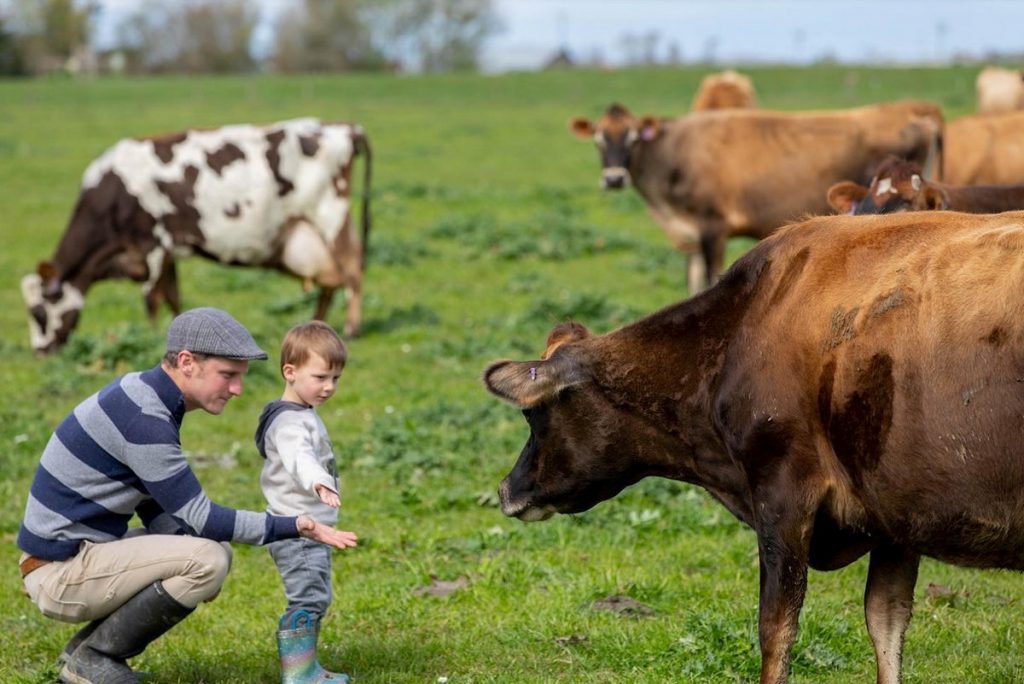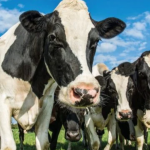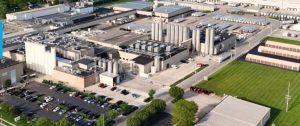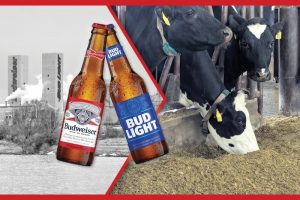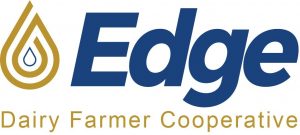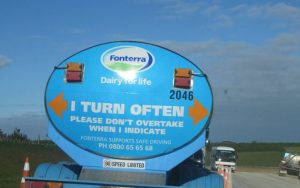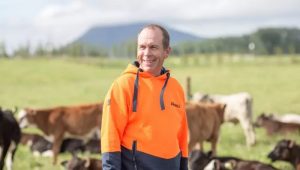
A USDA-funded initiative aims to transform and diversify the dairy industry, one small producer at a time.
At Jersey Scoops in Loleta, a small, unincorporated community in Northern California’s Humboldt County, the ice cream is as fresh as it gets. From pasture to parlor, its organic, butterfat-rich milk travels less than 10 miles, produced by a herd of Jerseys pasture-raised on the misty coast.
The shop’s freshly churned ice cream—with surprising flavors like Foggy Pebbles, made with cereal-soaked milk, and Danish Butter Cookie—has been drawing crowds. Since taking over a long-shuttered creamery earlier this year, Jersey Scoops has given the sleepy downtown a much-needed boost; customers routinely spill over to the park across the road, cone in hand, creating a potential reason for new businesses to fill the empty storefronts that once housed a cheese factory, bakery, and laundromat. Beyond Loleta, Jersey Scoops’ rainbow-labeled pints are making waves at local farmers’ markets, stores, and restaurants.
“We want to reinvigorate the community and revive Loleta’s dairy legacy.”
While revitalizing the community, Jersey Scoops adds a high-value outlet for a perishable product, strengthening the industry overall. But the owners of Jersey Scoops didn’t get here on their own; they leveraged a $60,000 grant from the Pacific Coast Coalition’s Dairy Business Innovation Initiative (PCC DBII) to secure both the space and equipment.
Despite the region’s history as a dairy powerhouse, locally made ice cream was previously nonexistent, says Thomas Nicholson-Stratton, who launched the venture with his husband, Cody. The ice cream shop is an extension of the Nicholson family’s sixth-generation, 120-acre farm in nearby Ferndale. Since taking over the dairy a decade ago and branding it Foggy Bottoms Boys, the couple has been bucking convention and helping their rural community navigate changing economic tides.

Foggy Bottoms Boys co-owners Thomas and Cody Nicholson-Stratton with their son at Jersey Scoops. (Photo credit: Will Suiter Photography)
“We want to reinvigorate the community and revive Loleta’s dairy legacy,” Nicholson-Stratton says of the 2,200-square-foot, eight-employee operation, noting the town’s history as a key producer of powdered milk. The scoops are also a platform for amplifying the dairy’s “very deliberate name,” he says, derived partly from the farm’s location on the foggy banks of the Eel River, but also reflecting its owners’ sense of humor: “We want to diversify the face of farming, because there are few places where young and queer people can see themselves in the field.”
The PCC DBII is one of four such initiatives across the country, funded by the United States Department of Agriculture’s (USDA) Agricultural Marketing Service. The national program helps small and mid-sized dairy producers squeeze more value out of milk by diversifying their products and markets, reducing waste, and innovating packaging and processing. With family dairies drying up in droves—the U.S. has 39 percent fewer dairies than five years ago, despite the same number of cows producing 5 percent more milk—the support aids smaller players in countering the forces of an increasingly consolidated industry.

A crowd forms outside Jersey Scoops during its ribbon-cutting weekend. (Photo credit: Will Suiter Photography)
The DBII also aims to strengthen the economic health of small and rural communities, says project director Carmen Licon-Cano. Foggy Bottoms Boys ticks many of the initiative’s boxes, creating a local milk product, she says, while invigorating a struggling downtown and adding a fresh take on the industry. “They’re really a shining example of the program.”
Building From the Bottom Up
California, the nation’s leading dairy state, produces nearly a fifth of the U.S. milk supply, mostly on industrial farms in the Central Valley. These farms hold, on average, around 2,300 cows. (Herds in Wisconsin, the second-largest producer, average 177 cows.) Across the nation, mega-dairies are becoming the norm, as more farms mirror the Golden State’s confined animal feedlot operations (CAFO).
These highly productive operations maximize returns in an industry with crushing profit margins. However, critics highlight their outsized environmental impact, including excessive water use and pollution caused by concentrated waste, as well as greenhouse gas emissions. CAFOs also face scrutiny for animal welfare issues due to confinement and extreme production demands. Meanwhile, the perishability of dairy’s main product exposes the industry to supply chain disruptions. At the height of the COVID-19 pandemic, failed shipping logistics forced farmers to dump millions of gallons of milk.
“It’s difficult for small businesses like us to be profitable. A lot of people don’t understand why my cheese costs [four times more than] Walmart’s.”
The 2018 Farm Bill established the DBII to spur innovation in the dairy industry and address the downward trend in milk consumption nationwide, caused at least in part by the proliferation of other beverages, including plant-based milks. Since then, the USDA program, which is overseen by Agricultural Secretary Tom Vilsack, a former dairy industry insider, has added post-pandemic support, both financially and technically, for producers and processors.
The initiative aims to “uplift the dairy sector” and strengthen local markets, says Susan Pheasant, director of California State University Fresno’s Institute for Food and Agriculture (IFA), which hosts the Pacific Coast Coalition DBII. With $165 million in total funding to date, regional DBIIs address the specific needs of four individual markets—northeast, southeast, midwest, and west coast. The PCC DBII includes academic partners such as Oregon State University as well as industry groups like the California Dairy Innovation Center. In addition to piloting new equipment, recipes, and processing techniques, the universities facilitate worker training and certificate programs in cheesemaking, food safety, marketing, and other specialized areas.
Some regions have expanded their focus to include climate-smart ranching practices, including managed grazing and resilient cropping systems, which can mitigate the environmental and climate impacts of industrial livestock production. But that hasn’t been the PCC’s focus, Pheasant says. As the last DBII to be established, in 2019, the region has received significantly less funding, so it has only focused on dairy processing. The PCC’s relatively modest grants target small and mid-sized operations, she says, to create an equitable field for producers.
For smaller enterprises, however, even modest grants can be transformative, Pheasant says. One artisan cheesemaker, for example, used a $100,000 award toward a cheese cutter that creates precisely measured wedges, eliminating an onerous manual task and allowing them to tap a new market that operates on uniformity and volume. And, because family, minority, and women-owned businesses often face greater challenges in securing capital, the funding can be “a real game changer,” she says, enabling them to compete at a far greater scale. “It’s a story that gets replicated through these small producers,” she adds.
“As an artisanal creamery, we need products that can really differentiate us from larger [operations],” says Todd Koch, owner of TMK Creamery in Canby, Oregon. Half an hour outside Portland, the 50-acre family farm is known for its ice cream and freshly churned cheddar, made from the milk of 20 pastured-grazed cows and sold a stone’s throw away at the farm stand and in a few local restaurants.
Several years ago, Koch collaborated with Oregon State University to develop a vodka distilled from whey, a byproduct of cheesemaking. “Cowcohol” has become one of TMK’s signature products, enabling the creamery to diversify with a premium, shelf-stable offering while minimizing a costly disposal problem.
Using a $140,000 DBII grant, TMK Creamery is now developing a filtration system to fully extract their whey’s remaining lipids and proteins—which are fed back to the cows, another savings. “It’s difficult for small businesses like us to be profitable,” Koch says. “A lot of people don’t understand why my cheese costs [four times more than] Walmart’s.”
“We’re an important fabric of these rural communities.”
These innovations often have ripple effects. At Nico’s Ice Cream, in Portland, Oregon, owner Nico Vergara concocts his frozen treats using a specialized blender imported from New Zealand. The machine swirls scoops of fresh fruit into the cream—both sourced from farms in nearby Willamette Valley—to create “a light and airy, soft-serve-y texture,” Pheasant says. “It’s one of a kind.”
In just three years, the 25-year-old entrepreneur, who started off with a seasonal pushcart, has opened two shops and now distributes pints to about 60 grocery stores in Oregon and Washington. Using a $40,000 DBII grant, he’s acquired an additional fleet of machines and is working toward nationwide distribution. With flavors that nod to Vergara’s Latino background, such as chamoy, a pickled fruit-and-pepper sauce, and Tajín, a brand of chili and lime seasoning, the company aims to broaden its product line and cater to an increasingly diverse consumer market.
With a third store in the works, Vergara’s success reflects the country’s voracious appetite for dairy—and the industry’s capacity to satisfy it. Despite waning milk consumption, Americans still consume a lot of cheese, yogurt, butter, and ice cream. Between 2021 and 2022, the average annual consumption of dairy products rose by more than 12 pounds per person, to an average of 667 pounds. And though the science is inconclusive around the health impacts, dairy products remain a staple in food assistance programs as a source of protein and other essential nutrients.
As the ballooning demand continues to shape market forces, the shift towards fewer, larger farms is inevitable, says Charles Nicholson, associate professor of agricultural and applied economics at the University of Wisconsin, Madison. With smaller-scale dairies harder hit by labor shortages and fluctuating milk prices, “this long-term trend would be hard to change with public policy or private initiatives [alone],” he says.

A few sleek Jersey cows from the Foggy Bottoms Boys pastures. (Photo courtesy of Foggy Bottoms Boys)
Nevertheless, the DBII and similar programs play an important role in supporting individual businesses and local communities, Nicholson says. And although his research found that diversifying milk production through more complex processing isn’t a sure path to profit, concentrating innovation close to the source tends to reduce the financial risks.
Ultimately, maintaining a diversity of production practices and locations bolsters resilience within the industry, Nicholson says, making it less vulnerable to disruptions in regional supply chains and climate-related issues. Consumers also benefit from greater access to a broader array of local and regional products.
The PCC also supports innovation through a larger lens, says PCC’s Lincon-Cano, providing office hours and technical assistance in equipment training and testing, as well as developing business and marketing plans. And by offering resources such as webinars and certificate programs in Spanish, the expanded access helps diversify the industry’s enterprise base, she says, which remains largely white despite the large number of Latinos in the greater workforce. Together, these strategic investments can contribute to a resilient, less consolidated system, one more closely tied to local economies and communities.
More Eyes Per Acre
As one of California’s oldest cheesemakers, Rumiano Cheese has a storied presence in the North Coast’s dairy shed. The company sources organic milk from 23 family farms, all of which pasture their herds within a 100-mile radius of the company’s Del Norte County cheese plant. “We’re an important fabric of these rural communities,” says Rumiano’s chief executive officer, Joe Baird, noting that many of the farms (including Foggy Bottoms Boys) supply them with milk. Many of these connections go back decades, he says, “so we don’t want to screw it up.”
Rumiano is using a $200,000 DBII grant to develop packaging for ready-to-serve and party-size cheese trays for the growing convenience market, which typically depends heavily on plastic. The funds will go towards retooling existing equipment to make new containers with more sustainable materials and less polymer, Baird says, and distinguish the brand from conventional competitors.
With industrial-scale operators flooding the market with “literally a billion pounds” of cheese, Baird says, innovation is vital to the survival of smaller producers. The diversity of players helps foster innovation, “just like tech and Silicon Valley,” he adds. Local dairy also supports the North Coast economy, which has been impacted by price collapses in cannabis, one of the region’s primary cash crops.
Smaller, family-run operations also have a deep commitment to their land and herds, Baird says. Organic and independently certified to meet animal welfare standards, these producers maintain regenerative practices, grazing cows in rotated paddocks to improve soil and pasture health.
These approaches often run counter to the commodity-driven model of CAFOs. Although pasture-based operations can vary in both size and practice methods, foraging requirements tend to limit herds to the hundreds, not thousands, says Steve Washburn, professor emeritus at North Carolina State University’s department of animal science and an expert in pasture-based and organic dairy production.
Run well, smaller-scaled systems have several advantages over confinement operations, Washburn says. Proper rotational grazing relies on pasture as the primary forage, cutting feed costs. Additionally, because cows spread manure uniformly across the paddocks, the waste enriches the soil and emits far less methane than it would decomposing in a collection pool.
Perhaps most importantly, the promotion of more small dairies creates a healthier agricultural ecosystem. The more dairies, the more farmer “eyes per acre,” Baird says, referencing Wendell Berry. “That’s why we’re so committed to supporting the viability of family-scale farms.” And without support for innovation, he adds, “this ecosystem is very much at risk.”
You can now read the most important #news on #eDairyNews #Whatsapp channels!!!
🇺🇸 eDairy News INGLÊS: https://whatsapp.com/channel/0029VaKsjzGDTkJyIN6hcP1K
